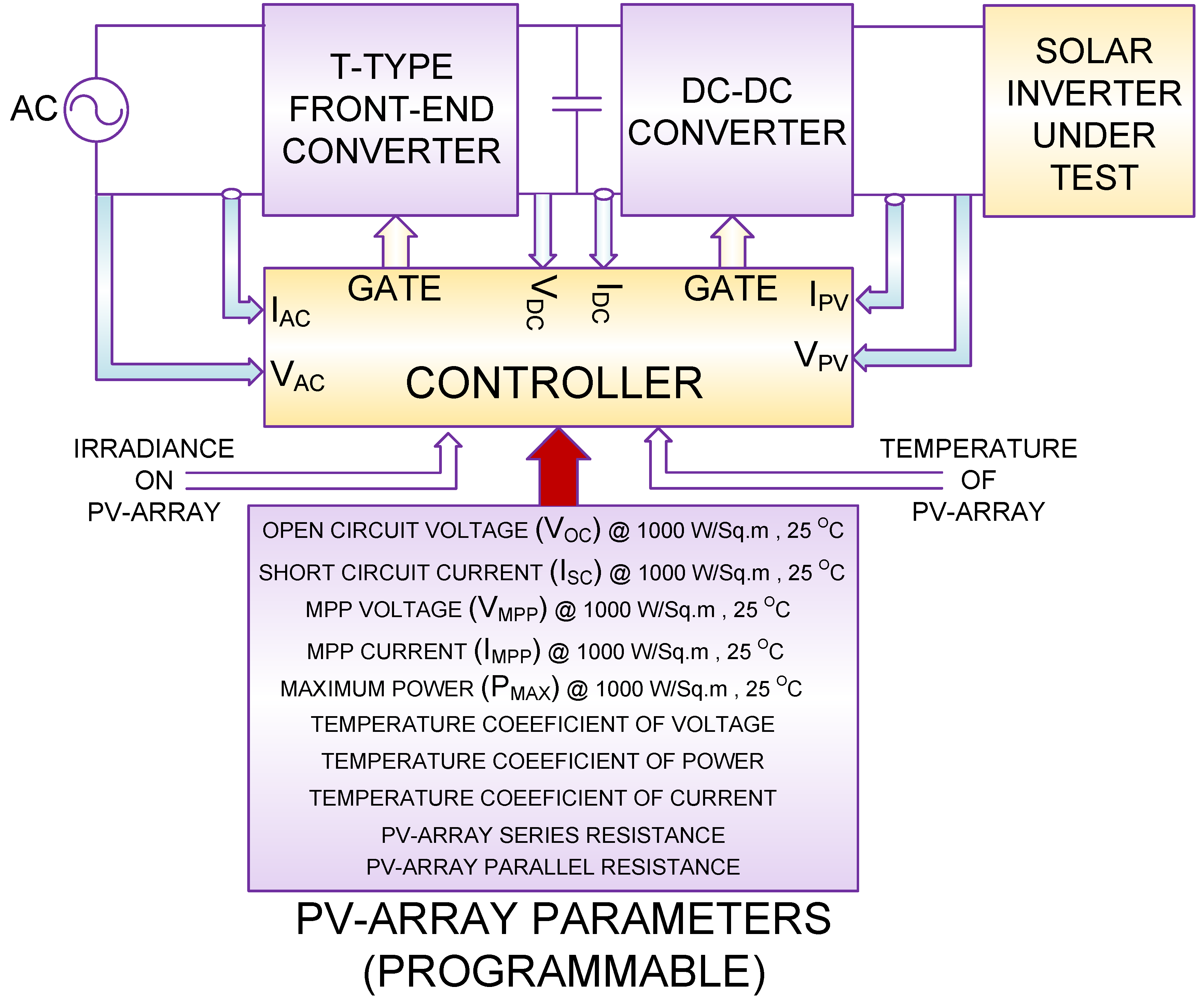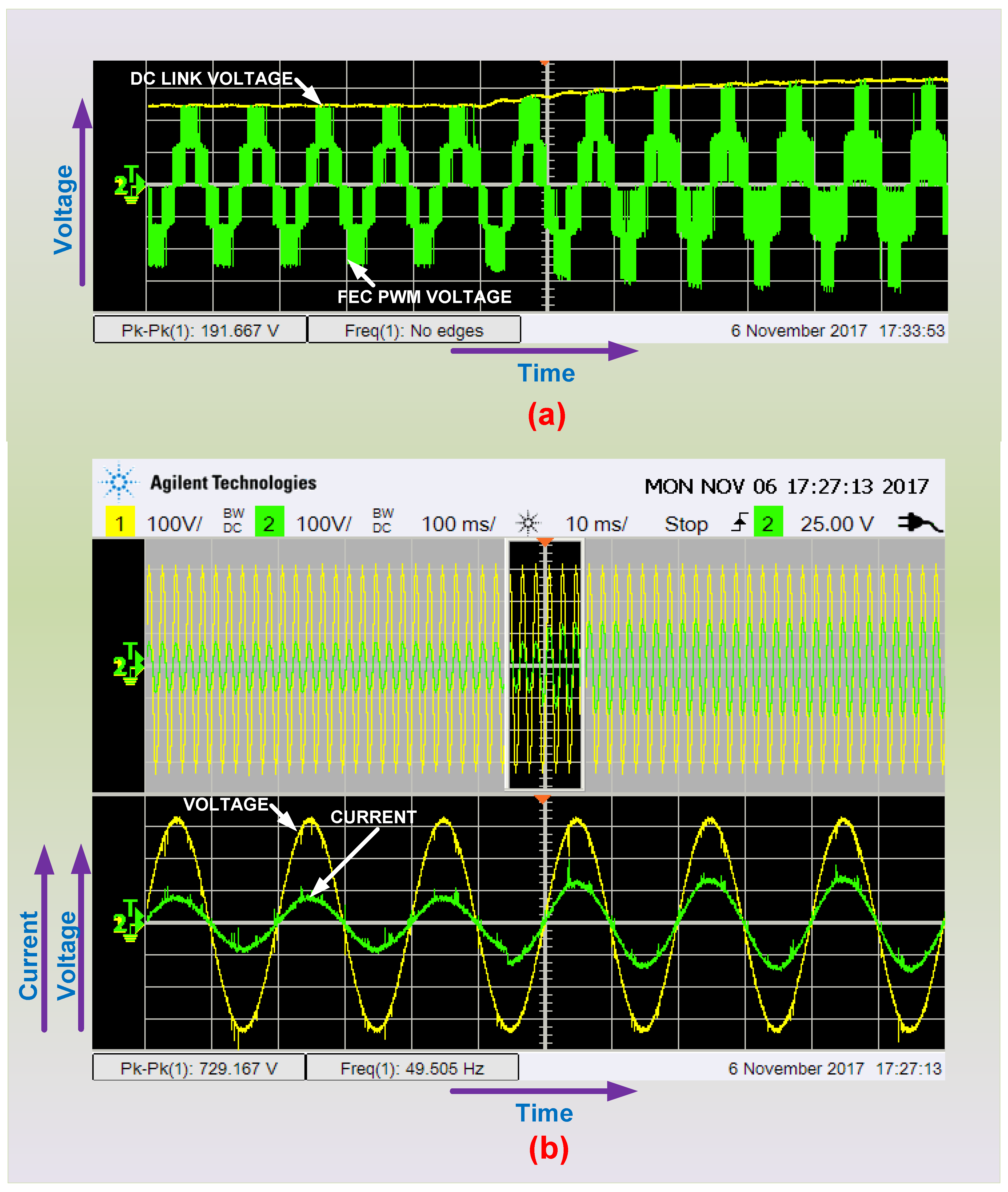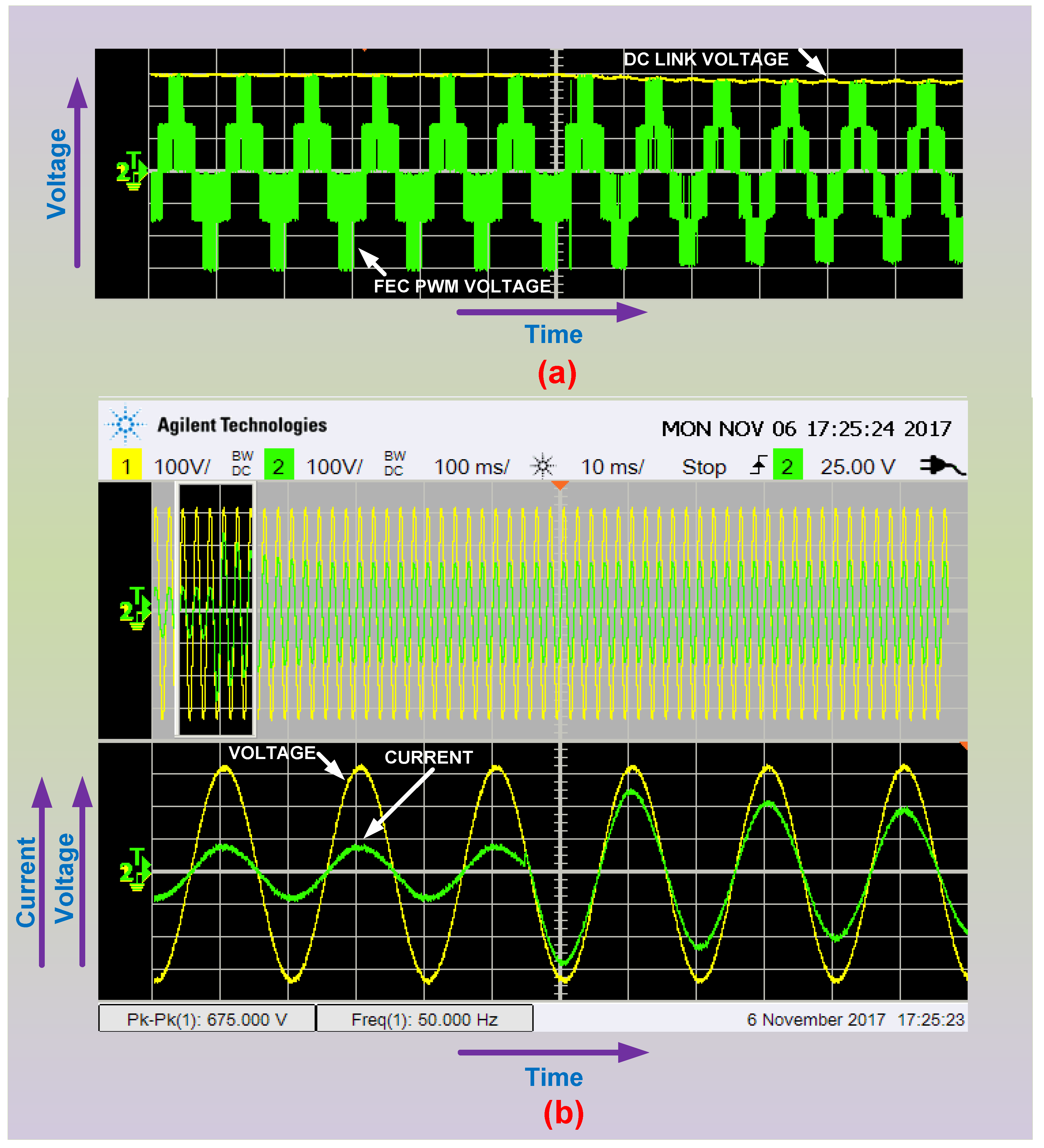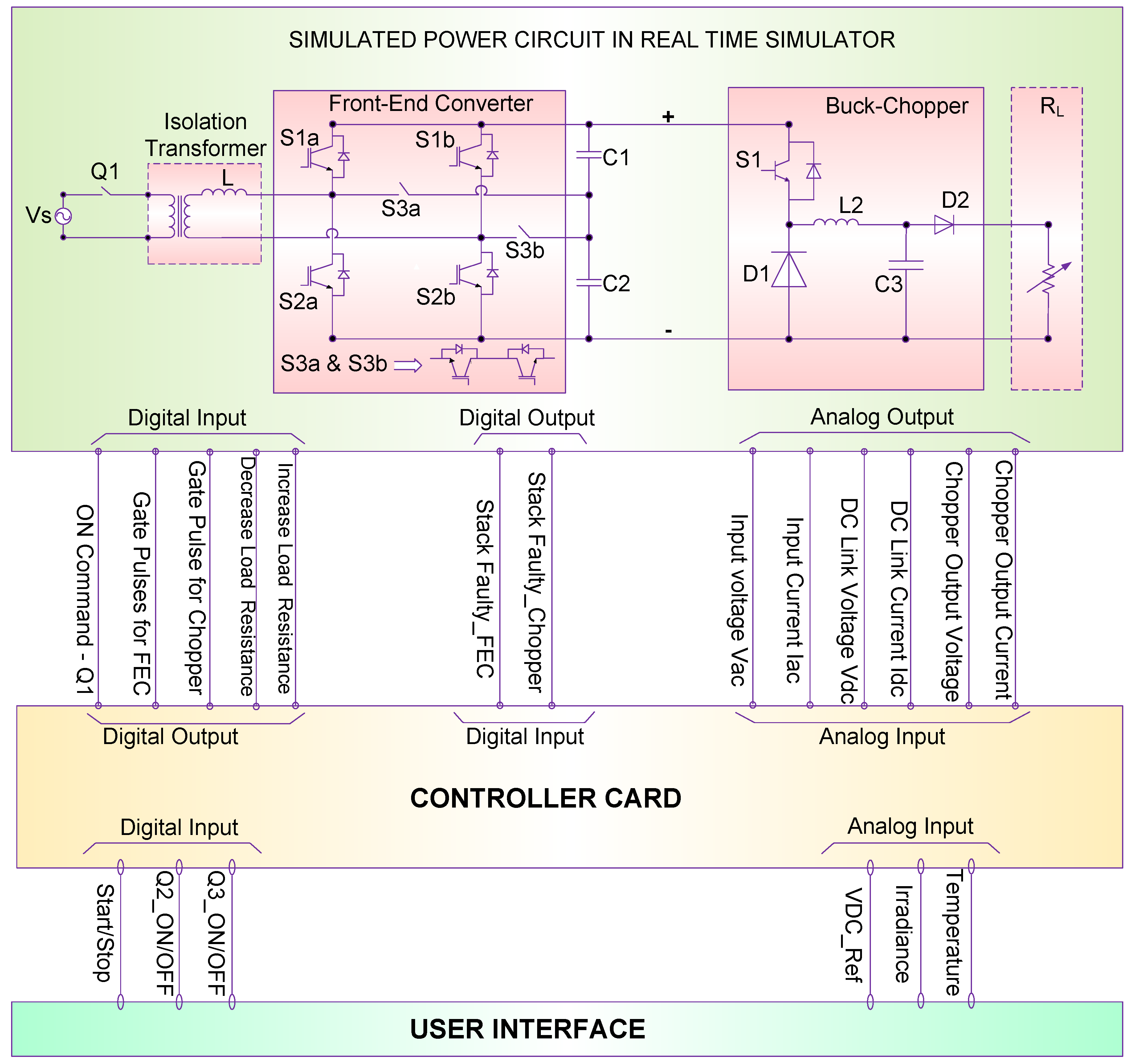Design and Controller-In-Loop Simulations of a Low Cost Two-Stage PV-Simulator
Abstract
:1. Introduction
2. A Three-Level T-Type Front-End Rectifier
2.1. Dynamic Response of FEC for a Step Change in Vdc_Ref
2.2. Dynamic Response of FEC for a Step Change in Idc
3. Buck-Chopper-Based DC-DC Converter
4. Real-Time Simulation Results
5. Future Scope
6. Conclusions
Author Contributions
Conflicts of Interest
References
- Jin, S.; Zhang, D.; Wang, C. UI-RI Hybrid Lookup Table Method with High Linearity and High-Speed Convergence Performance for FPGA-Based Space Solar Array Simulator. IEEE Trans. Power Electron. 2018, 33, 7178–7192. [Google Scholar] [CrossRef]
- Zhou, Z.; Macaulay, J. An Emulated PV Source Based on an Unilluminated Solar Panel and DC Power Supply. Energies 2017, 10, 2075. [Google Scholar] [CrossRef]
- Chang, C.; Chang, E.; Cheng, H. A High-Efficiency Solar Array Simulator Implemented by an LLC Resonant DC–DC Converter. IEEE Trans. Power Electron. 2013, 28, 3039–3046. [Google Scholar] [CrossRef]
- Chang, C.H.; Cheng, C.A.; Cheng, H.L. Modeling and design of the LLC resonant converter used as a solar-array simulator. IEEE J. Emerg. Sel. Top. Power Electron. 2014, 2, 833–841. [Google Scholar] [CrossRef]
- Mahmud, M.H.; Zhao, Y.; Wang, L. A high-bandwidth PV source simulator using a sliding mode controlled interleaved buck converter. In Proceedings of the IEEE International Conference IECON, Beijing, China, 29 October–1 November 2017; pp. 2326–2331. [Google Scholar]
- Koran, A.; LaBella, T.; Lai, J.S. High efficiency photovoltaic source simulator with fast response time for solar power conditioning systems evaluation. IEEE Trans. Power Electron 2014, 29, 1285–1297. [Google Scholar] [CrossRef]
- Zhang, W.; Kimball, J.W. DC–DC Converter Based Photovoltaic Simulator with a Double Current Mode controller. IEEE Trans. Power Electron. 2018, 33, 5860–5868. [Google Scholar] [CrossRef]
- Koran, A.; Sano, K.; Kim, R.Y.; Lai, J.S. Design of a Photovoltaic Simulator with a Novel Reference Signal Generator and Two-Stage LC Output Filter. IEEE Trans. Power Electron. 2010, 25, 1331–1338. [Google Scholar] [CrossRef]
- Cordeiro, A.; Foito, D.; Pires, V.F. A PV panel simulator based on a two quadrant DC/DC power converter with a sliding mode controller. In Proceedings of the IEEE International Conference on Renewable Energy Research and Applications (ICRERA), Padova, Italy, 22–25 November 2015; pp. 928–932. [Google Scholar]
- Kawano, M.; Sato, T.; Taguchi, T.; Genzima, Y.; Teramoto, S. Simple and low cost PV simulator using diode characteristics for development of PV system. In Proceedings of the INTELEC 2015—IEEE International Conference on Telecommunications Energy, Osaka, Japan, 18–22 October 2015; pp. 1–5. [Google Scholar]
- Özden, Ö.; Duru, Y.; Zengin, S.; Boztepe, M. Design and implementation of programmable PV simulator. In Proceedings of the IEEE International Conference on Fundamentals of Electrical Engineering (ISFEE), Bucharest, Romania, 30 June–2 July 2016; pp. 1–5. [Google Scholar]
- Seo, Y.T.; Park, J.Y.; Choi, S.J. A rapid IV curve generation for PV model-based solar array simulators. In Proceedings of the IEEE International Conference on Energy Conversion Congress and Exposition (ECCE), Milwaukee, WI, USA, 18–22 September 2016; pp. 1–5. [Google Scholar]
- Shinde, U.K.; Kadwane, S.G.; Keshri, R.K.; Gawande, S.P. Dual Mode Controller-Based Solar Photovoltaic Simulator for True PV Characteristics. Can. J. Electr. Comput. Eng. 2017, 40, 237–245. [Google Scholar]
- Piao, Z.G.; Gong, S.J.; An, Y.H.; Cho, G.B. A study on the PV simulator using equivalent circuit model and look-up table hybrid method. In Proceedings of the IEEE International Conference on Electrical Machines and Systems (ICEMS), Busan, Korea, 26–29 October 2013; pp. 2128–2131. [Google Scholar]
- Alemi, P.; Lee, D.C. Power loss comparison in two-and three-level PWM converters. In Proceedings of the IEEE International Conference on Power Electronics and ECCE Asia (ICPE & ECCE), Jeju, Korea, 30 May–3 June 2011; pp. 1452–1457. [Google Scholar]
- Schweizer, M.; Friedli, T.; Kolar, J.W. Comparative evaluation of advanced three-phase three-level inverter/converter topologies against two-level systems. IEEE Trans. Ind. Electron. 2013, 60, 5515–5527. [Google Scholar] [CrossRef]
- Masisi, L.; Choudhury, A.; Pillay, P.; Williamson, S. Performance comparison of a two-level and three-level inverter permanent magnet synchronous machine drives for HEV application. In Proceedings of the IEEE International Conference on Industrial Electronics Society (IECON), Vienna, Austria, 10–13 November 2013; pp. 7262–7266. [Google Scholar]
- Shin, H.; Lee, K.; Choi, J.; Seo, S.; Lee, J. Power loss comparison with different PWM methods for 3L-NPC inverter and 3L-T type inverter. In Proceeding of the IEEE Power Electronics and Application Conference and Exposition (PEAC), Shanghai, China, 5–8 November 2014; pp. 1322–1327. [Google Scholar]
- Labaki, R.; Kedjar, B.; Al-Haddad, K. Single-Phase Active Front End Converter with series compensation. In Proceedings of the IEEE International Symposium on Industrial Electronics, Montreal, QC, Canada, 9–13 July 2006; pp. 769–774. [Google Scholar]
- Huerta, F.; Stynski, S.; Cobreces, S.; Malinowski, M.; Rodriguez, F.J. Novel Control of Three-Phase Active Front-End Converter with Compensation of Unknown Grid-Side Inductance. IEEE Trans. Ind. Electron. 2011, 58, 3275–3286. [Google Scholar] [CrossRef]
- Sridhar, V.; Umashankar, S. A comprehensive review on CHB MLI based PV inverter and feasibility study of CHB MLI based PV-STATCOM. Renew. Sustain. Energy Rev. 2017, 78, 138–156. [Google Scholar] [CrossRef]
- Hou, C.C.; Cheng, P.T. Experimental Verification of the Active Front-End Converters Dynamic Model and Control Designs. IEEE Trans. Power Electron. 2011, 26, 1112–1118. [Google Scholar] [CrossRef]
- Sridhar, V.; Sanjeevikumar, P.; Umashankar, S.; Mihet-Popa, L. Power Balancing Control for Grid Energy Storage System in Photovoltaic Applications-Real Time Digital Simulation Implementation. Energies J. 2017, 10, 928. [Google Scholar]










| SL. No. | Reference | Configuration | Remarks |
|---|---|---|---|
| 1 | [3,4] | An LLC resonant DC-DC converter-based PV-simulator | This configuration requires a centre-tapped transformer and two inductors, two IGBT/MOSFET switches, etc. Cost and size of the system increases for higher rated systems due to the higher number of magnetic components. |
| 3 | [5,6] | PV-simulator based on an interleaved buck converter | This configuration requires three inductors and six IGBT/MOSFET switches. The cost of the system is comparatively lesser than [3,4]. |
| 3 | [7] | Buck-boost chopper-based PV-simulator | Cost of this system is comparatively lesser than [3,4,5,6] as this configuration requires two inductors and four IGBT/MOSFET switches. |
| 2 | [8] | Buck chopper-based PV-simulator with two stage LC filter | Two inductors are required at the output side of the chopper. The cost of the system is comparatively lesser than [3,4,5,6,7], but an additional L-C filter stage on the output side is costlier than a buck-chopper-based PV-simulator with a single L-C stage. |
| 2 | [9] | Two quadrant DC-DC converter-based PV-simulator with two stage LC filter | This configuration requires only one inductor on the output stage and two IGBT/MOSFET switches. Hence the cost of this configuration is less that that of the configurations presented in [3,4,5,6,7,8]. |
| 6 | [10,11,12] | Buck chopper-based PV-simulator with two stage LC filter | Buck-chopper-based PV-simulator is cheaper than the systems presented in [3,4,5,6,7,8,9] since this configuration requires only one inductor on the output stage and only one IGBT/MOSFET switch. |
| SL. No. | Electrical Parameter | Value | Units |
|---|---|---|---|
| PV Module Ratings | |||
| 1 | Module Power (P_Mod) | 435 | W |
| 2 | Open Circuit Voltage (Voc_Mod) | 85.6 | V |
| 3 | Short Circuit Current (Isc_Mod) | 6.43 | A |
| PV Array Ratings | |||
| 4 | No of Series Modules in PV Array (Nse) | 4 | No’s |
| 5 | No of Parallel Modules in PV Array (Np) | 10 | No’s |
| 6 | PV Array Power (P_Mod × Nse × Np) | 17.40 | kW |
| 7 | Maximum DC Voltage (Nse × Voc_Mod) | 342 | V |
| 8 | Maximum Output Current (Np × Isc_Mod) | 64.3 | A |
| SL. No. | Parameter | Description |
|---|---|---|
| Real-Time Simulator | ||
| 1 | Manufacturer | Opal-RT |
| 2 | Processor in Real-Time Simulator | Intel Xeon Quadcore 2.50 GHz |
| 3 | Operating System | QNX |
| 4 | IO Interface | FPGA Based |
| 5 | No of Analog Input Channels | 16 |
| 6 | No of Analog Output Channels | 16 |
| 7 | No of Digital Input Channels | 16 |
| 8 | No of Digital Output Channels | 16 |
| 9 | Analog Channels voltage Range | −10 to +10 V |
| 10 | Digital Channels Voltage range | 0 V = Logic Low, 15 V = High |
| 11 | Front-End Modeling tool | Matlab-Simulink |
| Controller Details | ||
| 12 | DSP Used | TMS320F2812 DSP |
| 13 | No of Analog Input Channels | 16 |
| 14 | No of Digital Input Channels | 16 |
| 15 | No of Digital Output Channels | 16 |
| 16 | No of PWM Outputs | 12 |
| 17 | Analog Channels voltage Range | −10 to +10 V |
| 18 | Digital Channels Voltage range | 0 V = Logic Low, 15 V = High |
| SL. No. | Electrical Parameter | Value | Units |
|---|---|---|---|
| PV Module Ratings | |||
| 1 | Maximum power of module at 1000 W/Sq.m | 435 | W |
| 2 | Maximum power of module at 600 W/Sq.m | 261 | W |
| 3 | MPP Voltage (Vmpp) at 1000 W/sq.m | 72.9 | V |
| 4 | MPP Current (Impp) at 1000 W/sq.m | 5.97 | A |
| PV Array Ratings | |||
| 5 | No of Series Modules in PV Array (Nse) | 4 | No’s |
| 6 | No of Parallel Modules in PV Array (Np) | 10 | No’s |
| 7 | PV Array Power at 1000 W/sq.m | 17.40 | kW |
| 8 | MPP Current of Array (Impp × Np) at 1000 W/sq.m | 59.7 | A |
| 9 | Maximum PV Array Power at 600 W/sq.m | 10 | kW |
| 10 | MPP Current of Array at 600 W/sq.m | 36 | A |
© 2018 by the authors. Licensee MDPI, Basel, Switzerland. This article is an open access article distributed under the terms and conditions of the Creative Commons Attribution (CC BY) license (http://creativecommons.org/licenses/by/4.0/).
Share and Cite
Vavilapalli, S.; Subramaniam, U.; Padmanaban, S.; Blaabjerg, F. Design and Controller-In-Loop Simulations of a Low Cost Two-Stage PV-Simulator. Energies 2018, 11, 2774. https://doi.org/10.3390/en11102774
Vavilapalli S, Subramaniam U, Padmanaban S, Blaabjerg F. Design and Controller-In-Loop Simulations of a Low Cost Two-Stage PV-Simulator. Energies. 2018; 11(10):2774. https://doi.org/10.3390/en11102774
Chicago/Turabian StyleVavilapalli, Sridhar, Umashankar Subramaniam, Sanjeevikumar Padmanaban, and Frede Blaabjerg. 2018. "Design and Controller-In-Loop Simulations of a Low Cost Two-Stage PV-Simulator" Energies 11, no. 10: 2774. https://doi.org/10.3390/en11102774






